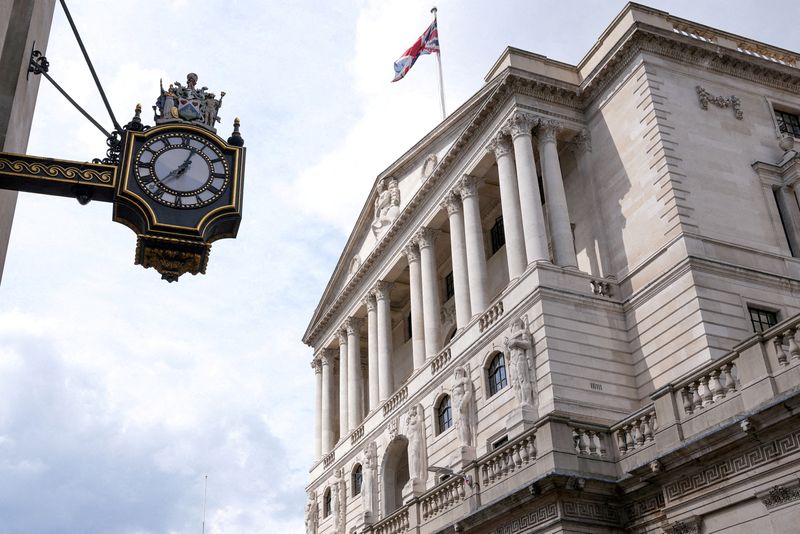Analysis-UK bonds and pound at centre of storm as tax shock hammers

© Reuters. FILE PHOTO: A general view of the Bank of England (BoE) building, the BoE confirmed to raise interest rates to 1.75%, in London, Britain, August 4, 2022. REUTERS/Maja Smiejkowska/File Photo
By David Milliken, Dhara Ranasinghe and Tommy Wilkes
LONDON (Reuters) – Britain’s bond market suffered its biggest daily fall in decades on Friday and is expected to slump further, as investors choked on the prospect of hundreds of billions of pounds in extra borrowing to fund tax cuts and energy bills.
Finance minister Kwasi Kwarteng’s plans will require an extra 72 billion pounds ($79 billion) of government borrowing over the next six months alone, and – a particular concern for investors – cement permanent tax cuts costing 45 billion pounds a year.
The market response was brutal, not just among bond investors but for sterling too, which sank to a fresh 37-year low against the U.S. dollar below $1.09, down more than 3% on the day.
The FTSE-100 blue-chip share index closed down 2%, its lowest close since mid-June.
“Today’s fiscal announcement constitutes a huge, unfunded gamble for the UK economy,” was the verdict of Ben Nabarro and Jamie Searle, economist and bond strategist at U.S. bank Citi, one of the primary dealers in British government debt.
Five-year gilt yields, which move in the opposite direction to prices, rose a massive 50 basis points on the day to a 14-year high of 4.06% – a rise over 15 times their normal daily move and the biggest daily increase since at least 1991.
Ten-year gilt yields jumped 33 basis points to 3.83%, their highest since April 2011 and a yield 1.78 percentage points higher than that offered for equivalent German government bonds, the biggest yield premium since the Bank of England gained independence in 1997.
Higher bond yields may appear abstract to those outside financial markets, but they directly increase the cost of new government borrowing, and indirectly push up interest rates for households and businesses.
For Kwarteng and new Prime Minister Liz Truss, the tax cuts are essential for a programme of deregulation that aims to boost Britain’s long-run growth by a full percentage point to 2.5%.
But to bond investors, they bring the prospect of more persistent inflationary pressures – at a time when inflation is already near a 40-year high – as well as tighter Bank of England (BoE) policy. Markets see BoE rates above 5% by August next year, a vertiginous from rise 2.25% now and just 0.1% in 2021.
Government borrowing is likely to total 218 billion pounds this financial year and 229 billion pounds in 2023/24, Citi predicted, and it expects benchmark 10-year British government bond yields to rise to 4.25%.
NatWest, another primary dealer, sees 10-year yields rising even higher to 4.5%.
“The government have announced a pandemic-scaled fiscal stimulus … but without the offsetting monetary policy stimulus, in the form of QE, to absorb all the additional issuance,” NatWest economist Ross Walker and…
Read More: Analysis-UK bonds and pound at centre of storm as tax shock hammers
